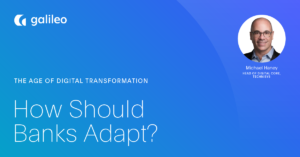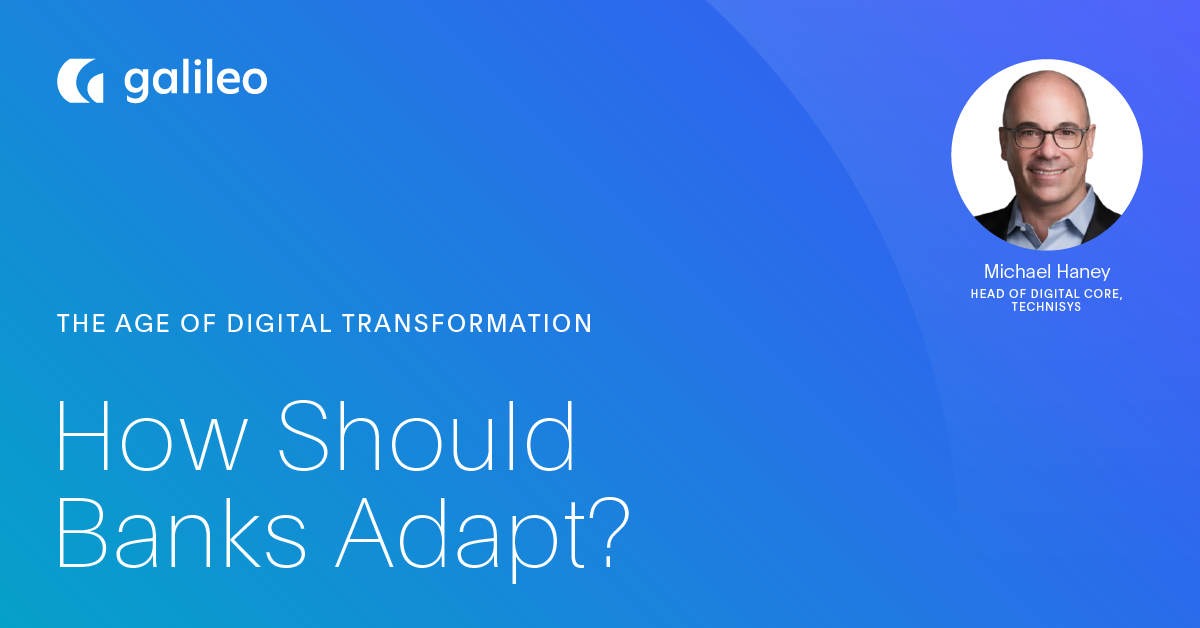
Banking is going digital fast–and you need to figure out how to compete with digital-first fintech challengers. Here’s what you need to know to stay competitive.
In the following interview, Michael Haney, Head of Digital Core for Technisys, discusses the evolution of banking’s digital transformation and how banks can retain market share amid stiff competition from newer entrants.
How has the concept of digital transformation in banking changed over the years?
Initially banks thought it was enough to launch new digital self-service channels, such as an internet banking portal, or a mobile application. This helped to eliminate the need for branches or devices such as the ATM, while accelerating the move to banking anytime, anywhere.
The focus then moved to digitizing the physical world of paper and plastic. Everything from monthly statements to debit cards to cash itself became the target, as the cost to manage and process these items ate into the banks’ earnings.
Finally, incumbent banks shifted their attention to automation of business processes. The goal was to remove bank employees from the process to eliminate human error, reduce costs, and improve scalability.
Why has this proven to be insufficient to truly transform the industry?
The common theme in those examples is cost reduction, either by eliminating labor, real estate, or physical items, such as checks. The focus was on productivity of existing business models, so it was a very bank-centric approach to the adoption of digital technologies. Improvement to the bank’s operational efficiency was the challenge being addressed.
These days the industry is focused on changing its business models entirely, by putting the goals of the customer first. Banks and their fintech challengers are now using technology to create new digital-first products and services. They are embedding them at the point of need for the customer, no longer limiting their distribution to their own closed ecosystem of channels.
What are some examples of these new digital-first products and services?
Customers are seeking more than just the ability to transact. They are seeking help to manage their finances in ways that meet their goals, such as better abilities to manage cash flow. Early wage access and buy now, pay later solutions help customers access funds when they need them, and pay back these advances over time, all without the need to utilize credit. Personal financial management (PFM) solutions help customers understand how their money is being spent and address ways to prevent unwanted expenses or account balance shortfalls.
Customers are also searching for solutions that help them optimize their savings and align their savings to future goals. Data analytics from these same PFM solutions can help uncover opportunities to save, automate savings, and thereby reduce the overall effort required by the customer to save and invest.
What has prevented the incumbent banks from being the first to launch these capabilities?
Banks that invested solely in a front-end customer engagement platform eventually hit a wall. As they try to move beyond providing transaction services on their digital channels, they realize their middleware and back-end solutions can’t transform in the ways they need them to, or at least cannot do so without a lot of effort and cost. Their middleware needs to contain customer journeys that are not only agnostic to the bank’s own channels, but also allow the bank to embed these journeys into external brands, where the customer truly needs them.
The bank’s back-end platform needs to be configurable in ways that break down traditional system silos and allow for the combination of products and services that help solve unique customer pain points. The back-end systems also need the agility to change at the same speed as the newer front-end systems, which many of the older platforms are incapable of doing.
How can banks enable this change to keep up with the Fintech challengers?
“Banks will first go through an internal cultural transformation. This involves adopting a customer-centric approach using design thinking principles to ensure they are solving customer needs and not just their own needs.” – Mike Haney, HEAD OF DIGITAL CORE
The ability to adopt agile methodologies and the concept of continuous development and deployment requires not only retraining and reorganizing their staff but shifting budgets from a capital expenditure to an operating expenditure model.
Finally, they need to adopt tools and platforms that enable rapid-test and learn models, involve the customer in the design process, and most importantly allow the staff to focus on customer problems. Today, banks are still too focused on challenges that are not core to customer-centric banking, such as running a data center. This can be accomplished by moving to a cloud environment, adopting a low-code development platform, and using collaborative tools to bring together a mix of in-house disciplines, as well as the customers themselves.
What other advice would you give to banks to future-proof their businesses?
We cannot underestimate the impact that advanced data analytics will have to improve the customer experience and uncover opportunities for the banks. Banks have historically used data analytics largely for marketing purposes, and more recently to help fight financial crimes such as fraud or money laundering. Newer business intelligence tools are allowing banks to react to events in real time and shift from models that were only predictive to ones that are adaptive and self-learning.
Again, we will see a shift in the application of these technologies from simply helping the bank drive revenue or reduce risk, to being able to help their customers reach new levels of financial health and wellness. The abilities of these technologies to scale in a cost-effective manner will allow banks to apply these AI technologies to all customer segments, not just the affluent clients.
Click here for Haney’s Top 3 Tech Priorities for FIs Heading into 2023.
Click here to learn more about how banks can compete with fintechs.
Note: This article was originally published on technisys.com which was acquired by SoFi Technologies in February 2022 and is the parent company of Galileo.


